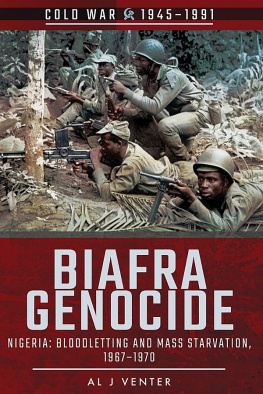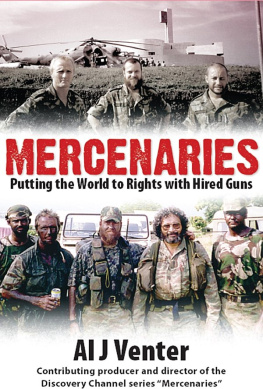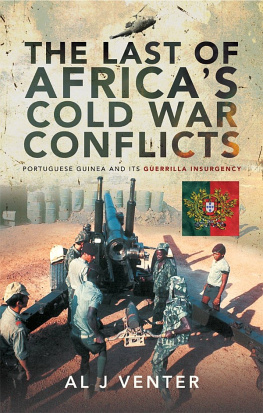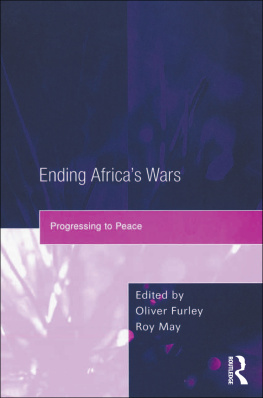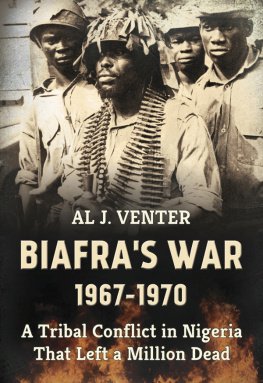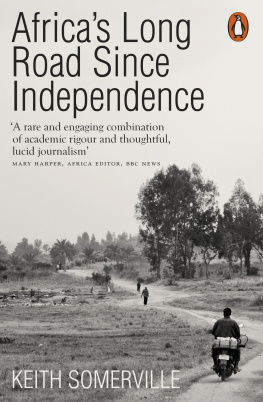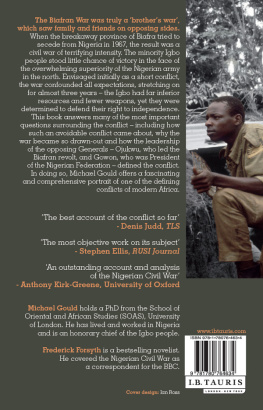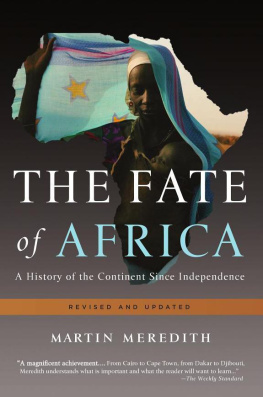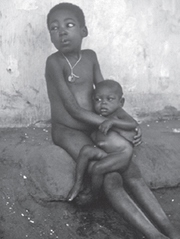BIAFRA GENOCIDE
NIGERIA: BLOODLETTING AND MASS STARVATION, 19671970
AL J. VENTER
(Photo CDC/ Dr Lyle Conrad)
First published in Great Britain in 2018 by
PEN AND SWORD MILITARY
an imprint of
Pen and Sword Books Ltd
47 Church Street
Barnsley
South Yorkshire S70 2AS
Copyright Al J. Venter, 2018
ISBN 978 1 526729 13 2
eISBN 978 1 526729 14 9
Mobi ISBN 978 1 526729 15 6
The right of Al J. Venter to be identified as the author of this work has been asserted in accordance with the Copyright, Designs and Patents Act 1988.
A CIP record for this book is available from the British Library All rights reserved. No part of this book may be reproduced or transmitted in any form or by any means, electronic or mechanical including photocopying, recording or by any information storage and retrieval system, without permission from the Publisher in writing.
Every reasonable effort has been made to trace copyright holders of material reproduced in this book, but if any have been inadvertently overlooked the publishers will be pleased to hear from them.
Pen & Sword Books Ltd incorporates the imprints of Pen & Sword Archaeology, Atlas, Aviation, Battleground, Discovery, Family History, History, Maritime, Military, Naval, Politics, Railways, Select, Social History, Transport, True Crime, Claymore Press, Frontline Books, Leo Cooper, Praetorian Press, Remember When, Seaforth Publishing and Wharncliffe.
For a complete list of Pen and Sword titles please contact
Pen and Sword Books Limited
47 Church Street, Barnsley, South Yorkshire, S70 2AS, England
email: enquiries@pen-and-sword.co.uk
website: www.pen-and-sword.co.uk
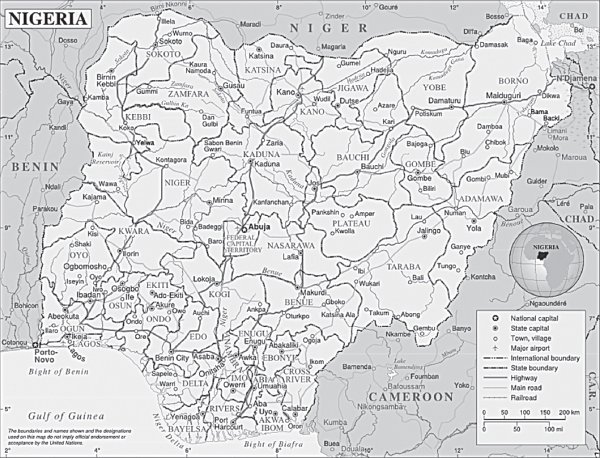
Political map of Nigeria. (UN)
TIMELINE
| 1960 : | Nigeria becomes an independent state within the Commonwealth after sixty years of British colonial rule. The new head of state is Prime Minister Sir Abubakar Tafawa Balewa, a northerner who heads a coalition government. |
| 1962/1963 : | Two controversial censuses take place throughout the country, the first in December 1962, followed by another a few months later, both of which have roots in the differences between southern (mainly Christian and animist) and largely Muslim northern Nigeria, and fuelling regional and ethnic tensions. |
| 19621965 : | The Tiv tribe of Nigerias so-called Middle Belt area of the North grow increasingly intolerant of Muslim-orientated rule and openly riot for almost three years because of perceived domination by Muslim northerners. |
| 1964/1965 : | The general election that takes place November to March is alleged neither free nor fair. All devices imaginable are used by the ruling regional parties to eliminate opponents. NorthSouth tensions are exacerbated with violence between ethnic groups. |
| 1966 |
| January: | Sir Abubakar Balewa and several other northern political and religious leaders are killed in a southern-led army coup dtat headed by Major Nzeogwu. The declared aim is to establish a strong, unified and prosperous nation, free from corruption and internal strife. Within days Major-General Johnson Aguiyi-Ironsi forms a new military government staffed mainly by southern officers and with only a token number of Muslim northerners. |
| May: | Riots occur throughout northern Nigeria during which many easterners residing in the North are attacked and killed. |
| July: | A counter-coup is staged by northern military officers on 29 July with two aims: revenge on the East for the earlier murders of traditional leaders and a break-up of the Nigerian Federation of States. In the process General Ironsi is killed and replaced by Lieutenant-Colonel Yakubu Gowon, a Christian and trusted officer from the countrys central regions. |
| August: | Troops of eastern Nigerian origin serving elsewhere in the country are officially and formally released and posted to Enugu, the capital of the Eastern Region, while troops of non-eastern origin in Enugu are moved to Kaduna in the north and Lagos in the west. This marks the beginning of division and disunity within the rank and file of the Nigerian armed forces. |
| September: | Senseless looting and killing spread throughout northern Nigeria, with tens of thousands of southernersmainly from the Eastern Regionindiscriminately slaughtered. The majority of easternersthose who still canflee to their tribal homeland. |
| October: | Lieutenant-Colonel Odumegwu Ojukwu, commander of Nigerias Eastern Regionwho played no part in either of the military coupsbroadcasts from Enugu that if the killings are not halted, he will be forced to take steps to stop the violence. |
| 1967 |
| January: | Following a virulent war of words between the East and the North, peace talks between the Supreme Military Council of the Federal Republic of Nigeria and the countrys Eastern Region are held under the auspices of Ghanas head of state, General Ankrah, in Aburi, Ghana. Nothing comes of the talks in spite of efforts at reconciliation by eminent Nigerians, Emperor Hallie Selassie of Ethiopia and Dr Martin Luther King. |
| May: | The Nigerian Federal government divides the country into twelve states on 27 May 1967, with the Eastern Region subdivided into three states; the promulgation is rejected out of hand by Ojukwu. |
| June: | Ojukwu seizes Federal government property and funds in the East. He plans the hijacking of a national commercial aircraft, a Fokker F27, on a scheduled flight from Benin to Lagos. All these and other indications together with a succession of intelligence reportsconvince the Federal Military Government of Ojukwus intention to secede. Colonel Yakubu Gowon, the head of the Federal government imposes a total blockade of the East. By now both adversaries have started preparing for war. |
| July: | Hostilities erupt on 6 July as the southeastern regions of Nigeria secede as the Republic of Biafra, sparking a bloody civil war that is to last three years. |
July 1967January 1970
The war that followed was a savage and often brutal battle for dominance between Federal forcessupported by Britain and the Soviet Union (obviously the oil that lay under Biafran earth had a lot to do with that unlikely alliance)and a tiny enclave that was soon completely surrounded by its enemies. Much of what took place during almost three years of bitter fighting is both confused and puzzling because it all happened in a comparatively small region where travel was perilous because of Nigerian jet fighters hitting anything that moved on the roads. Also, the front could often move three or four times in a single day.
Accurate reports of what actually went on between the warring parties were invariably sketchy for several reasons, the first being heavy levels of censorship imposed on all news reports (and access) pushed out by news hacks and independent observers by the Lagos government. In contrast, that did not happen that often with Biafran events because, simply put, there was nobody there to report on it. None of this authors reports or scores of photographs were ever censored by Ojukwus representatives.
Nigerias restrictions were severe. For instance, the MiniCon rocket attack on the merchant ship Titania on which I was travelling and which was hit by rocket fire while moored in the Warri roadsteadnever made news. I wrote my report, hired a boat to take me into Warri town, and submitted the story to be telegraphed to the Daily Express in London (for which I paid a bundle); it was spiked by Federal goons. My editors never saw it. More salient, actual sequences of events, battles, attacks and the rest sometimes made little sense because both the Federals and Ojukwus people channelled everything to do with hostilities through their respective public relations people, the latter in Geneva. The truth is that both would do their best to either obfuscate what actually happened or embellish it. That made nonsense of some events which would simultaneously appear the next morning in competing newspapersthe Times or the London Daily Mail , for instance and might indeed have happened on different continents the way they were presented.

